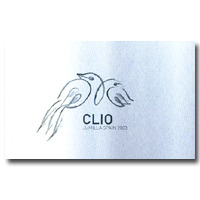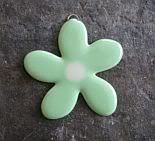
The ecWino crew just returned from a trip to Maine to attend the Maine Organic Farmers and Growers Association's Common Ground Fair. We try to attend this celebration of rural living every year, and this year was phenomenal.
On our way up, it dawned on me that we'd be passing Freeport, home to Maine Distilleries. We just had to stop for some goodies...

Cold River (showered that morning)
Maine Distilleries is the maker of Cold River Vodka ($$-$$$), which I've mentioned before. I still feel that this is the most underrated vodka in America, and a must buy.
I chatted with one of their employees about the lack of advertising or promotion in Connecticut and how that has led to poor sales. They've just introduced 187ml bottles (nippers, you drunks) that are retailing for about $4 in CT. If you see one, buy it, as this is the only real way I could ever convince you to buy a $45 vodka you've never heard of.
We checked out the distillery, as well as a collection of artifacts related to the Cold River Aquifer. We checked out tons of press they've received, including The Spirit Journal's rave, "Smooth as silk, yet complex and layered. A coming superstar." Then we drank.
Normally when one tastes a new vodka for the first time, the edge of the glass is held 2 1/2 to 3 inches from the nose. Not with Cold River, however. You can jam your schnozz right into the glass. It doesn't overpower on the nose, delighting you with the scent of farm-fresh potatoes. The smoothness of the nose gives you an idea of the taste. It's smooth, refined, and elegant. It has a sense of lemon zest on the tongue, and then it leaves. There is almost no aftertaste.
We loaded up with some goodies -- t-shirts and such. We did not buy large quantities of the vodka at unbelievably low distillery pricing, because CT law won't allow us to drive it back into the state. Ya heard that, Rell?! We did NOT buy large quantities for return to the state. Then we headed off to the fair.
We set up camp just outside of Unity, Maine, and headed on down to the local gas station to pick up some beers (BEE-UHHS). Yes, Connecticut, beer and wine are sold at gas stations in Maine -- you can guess what the selection is like. Troy General, the all purpose gas/beer/deli/deer-check station, has a better beer selection than most however.
Feeling "touristy", we opted for Portland, Maine's own Shipyard Brewing Company's Export Ale ($). This American Pale Ale pours a crisp body with a golden color and a fragile head that doesn't last after the first sip. It has a "citrusy" taste with a very light mouthfeel. This isn't a remarkable beer, but definitely a good daily-drinker. I would buy it again.
During our first day at the fair, we found some locally grown blueberries at the Farmer's Market. Heading back to camp, we stopped by Troy General again, this time grabbing Atlantic Brewing Company's Bar Harbor Blueberry Ale ($). Atlantic is out of Bar Harbor, Maine (and will be discussed later).
Stealing an idea from Salem Beer Works in Salem, Mass., we poured the blueberry ale over the fresh blueberries in our lexan pint glasses (even backpackers need proper glassware!).
The beer itself is a deceiving pale copper color, with only a hint of the blueberry in the nose. Blueberry is in the taste, but it's not overpowering. There's a generous amount of malt to balance out the fruit, but again, not overpowering. The perfect amount of hops finishes out the taste, and reminds you that you're drinking BEER. This is no stunt-brew. Quite possibly the most balanced fruit beer I've ever tried, this is a must buy.
That night we attended a large bonfire with other area campers on the grounds of a local hunting lodge. Our host brought out some homemade wine that his wife kept referring to as "Pear Champagne". Pear Champagne apparently is what happens when you scare off all the pear-eating deer with your big guns and now have an overabundance of wild pears and a bucket of "Champagne yeast". There's no real need to describe pear champagne other than to offer this advice:
Two of our lexan wine glasses (yep, backpackers need those, too!) were summarily destroyed, as I just couldn't rid them of the pear champagne smell.
Mo had never been to Acadia National Park, and as it turns out, they've got a few wineries out there. So we packed up and headed down east.
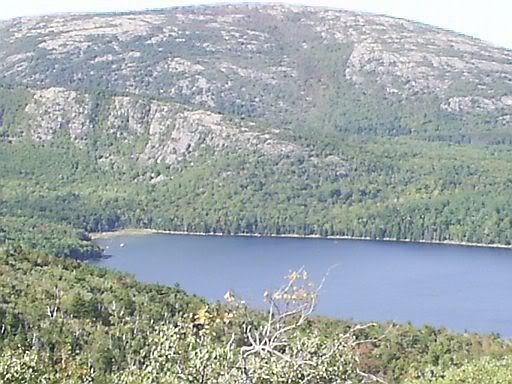
It doesn't really look like this area could offer the type of environment to grow grapes properly, so I just had to sample as much as I could.
We stopped first at Sweet Pea's Farm in Bar Harbor, home to Bar Harbor Cellars, a division of Atlantic Brewing Company. They've only just started to plant their own grapes (see below), mostly hybrids, due to the almost yearly 42 inches of frostline. They currently purchase their grapes from Tuscany.
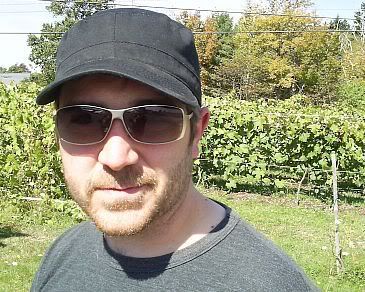
ecWino at Sweet Pea's Farm and Winery, Bar Harbor (3 days, no shower)
I really got the impression that the place was a typical Maine tourist trap. It was chock full of bad fruit wines, served overly chilled. They had a couple of grape wines (merlot, Pinot Noir) that were awfully balanced as a result of making them without any tannins. "No tannins means no headaches!" was repeated often enough to become their mantra. They did, however offer a decent Zinfandel, full bodied and peppery, which I would have purchased, if only I had a way to get it back into CT.
That day we also went out to the home of Atlantic Brewing to check out what they had to offer besides blueberry beer.
I was immediately impressed by their Mount Desert Island Ginger Beer ($). A wheat ale brewed with copious amounts of ginger, this beer was spicy enough to be interesting, but well balanced by its malt. If you can find it, this beer is a must buy.
We grabbed a few of their beers and headed down to the town of Manset, where we camped out near a natural seawall.
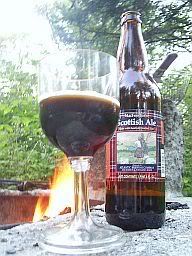
The MacFoochies Scottish Ale ($) poured a nice coffee color, with a creamy thick head. This beer was complex with notes of barley, chicory, coffee, chocolate, and toffee. The aftertaste was big and smoky. It lingered for just a bit and then was gone, inviting the next sip. This was possibly my favorite beer of the entire trip, and definitely a must buy.
Brother Adam's Bragget Ale ($-$$) was a barleywine style ale brewed with honey (sorry, vegans). The taste had notes of cherry and apple, cut into by a brandy-like flavor of honey. It was by no means the best bragget I've ever tasted, but if I saw it again, I'd probably pick it up. While it showed no signs that it would improve with, or stand up to, aging, I was assured by the brewery staff that it could go for up to ten years.

outside Bartlett Maine Estate Winery (4 days, no shower)
The next day, we headed out to Schoodic Peninsula and to the Bartlett Maine Estate Winery.
I was impressed to find that they were not attempting to make grape wines, but were instead using the exact methods of normal winemaking with fruits grown on their own estate.
These fruit wines were nothing like Grandma's old Boone's Farm. These wines had character and complexity that one would expect in a California Cult Wine or rare French Vintage.
I swore their Wild Blueberry Oak Dry wine had all the elements of a fine Merlot, with the perfect balance of fruit and dryness.
Their French Oak Dry Pear, aged in new french oak, was reminiscent of a fine Riesling.
The more we sampled, the more we were amazed that with the proper technique, equipment, and passion, these fruits could be made into something actually deserving of the title, Wine.
We of course, did not purchase several cases, what with CT law and all. It's a real shame, though, because I'd really be into trying a bottle of the Wild Blueberry Oak Dry Winemaker's Collection in the autographed bottle right now.
Cheers from Maine!
p.s. best bumper sticker seen in Maine...
